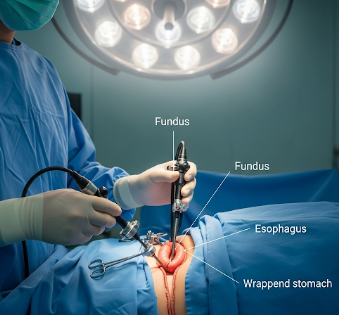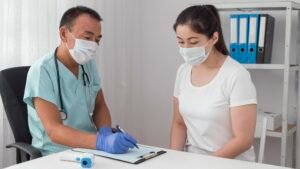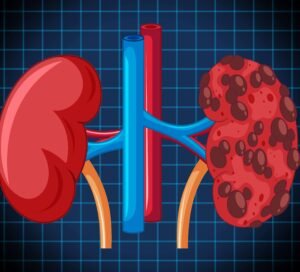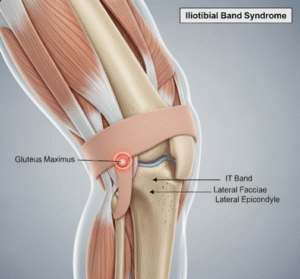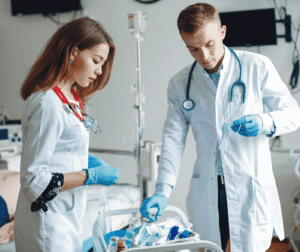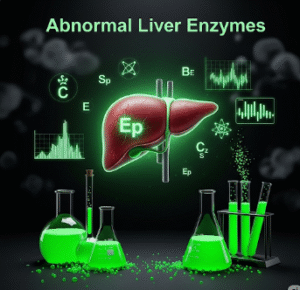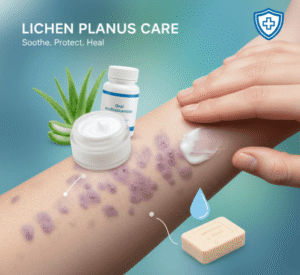Overview
Laparoscopic Nissen Fundoplication is a minimally invasive surgical procedure used to treat gastroesophageal reflux disease (GERD) and hiatal hernia. The surgery involves wrapping the upper part of the stomach (fundus) around the lower esophagus to strengthen the lower esophageal sphincter and prevent acid reflux.
In Korea, this procedure is performed by experienced gastrointestinal and bariatric surgeons using laparoscopic techniques, which reduce pain, shorten hospital stays, and improve recovery time.
Highlights:
- ✅ Treats chronic acid reflux (GERD) and hiatal hernia
- ✅ Minimally invasive with faster recovery
- ✅ Reduces need for long-term medications
What is Laparoscopic Nissen Fundoplication?
Nissen Fundoplication involves wrapping the fundus of the stomach 360 degrees around the lower esophagus. This creates a valve mechanism that prevents stomach acid from flowing back into the esophagus, effectively treating GERD symptoms.
Indications include:
- Chronic gastroesophageal reflux disease (GERD) resistant to medication
- Hiatal hernia causing reflux or discomfort
- Esophagitis or Barrett’s esophagus secondary to reflux
- Patients seeking a long-term solution to acid reflux
Important: This procedure is usually considered when medications and lifestyle changes fail to control reflux or when complications from GERD develop.
What are the benefits?
- Long-term reflux control: Reduces acid exposure and esophagitis
- Symptom relief: Reduces heartburn, regurgitation, and chest discomfort
- Minimally invasive: Smaller incisions, less postoperative pain, and faster recovery
- Reduced medication dependence: Often eliminates the need for long-term acid suppression
Key benefits highlighted:
- ⚡ Minimally invasive laparoscopic approach
- ⚡ High success rate in controlling GERD symptoms
- ⚡ Corrects associated hiatal hernia
- ⚡ Improves quality of life and daily comfort
Procedure Details
1) How should I prepare for Laparoscopic Nissen Fundoplication?
- Preoperative evaluation: Endoscopy, barium swallow, and imaging to assess esophagus and stomach
- Medication review: Adjust or pause blood thinners or other medications as instructed
- Fasting: Usually 6–8 hours before surgery
- Consent and education: Discuss procedure, risks, expected outcomes, and recovery
- Lifestyle preparation: Stop smoking and maintain a healthy diet for better healing
2) What happens during Laparoscopic Nissen Fundoplication?
- Anesthesia: General anesthesia administered
- Port placement: Several small incisions made in the abdomen for laparoscopic instruments
- Fundus wrapping: Upper part of the stomach is wrapped 360 degrees around the lower esophagus
- Hiatal repair: If a hiatal hernia is present, the diaphragm opening is tightened
- Closure: Incisions closed with sutures or adhesive strips
Duration: Typically 1–2 hours depending on patient anatomy and presence of hernia
3) What happens after Laparoscopic Nissen Fundoplication?
- Recovery monitoring: Vital signs, pain control, and early mobilization
- Pain management: Analgesics administered as needed
- Dietary guidance: Start with liquids and gradually progress to soft foods
- Follow-up care: Monitor swallowing, incision healing, and reflux symptoms
Highlights for post-procedure care:
- ⚡ Mild bloating, discomfort, or gas may occur initially
- ⚡ Avoid heavy lifting or strenuous activity for several weeks
- ⚡ Gradually progress diet as instructed
- ⚡ Attend follow-up appointments to monitor outcomes and detect complications early
Risks / Benefits
Risks:
- Temporary difficulty swallowing (dysphagia)
- Gas-bloat syndrome
- Infection at incision sites
- Rare complications: esophageal injury or anesthesia-related issues
Benefits:
- Long-term control of GERD symptoms
- Minimally invasive approach with shorter recovery
- Reduces or eliminates dependence on acid-suppressing medications
- Corrects hiatal hernia when present
Recovery and Outlook
- Hospital stay: Usually 1–2 days for most patients
- Full recovery: 2–4 weeks; diet gradually returns to normal
- Long-term outlook: Excellent control of acid reflux symptoms; reduced risk of esophagitis and GERD complications
- Follow-up: Regular postoperative visits to monitor swallowing, reflux symptoms, and incision healing
Tips for optimal recovery:
- ✅ Follow dietary instructions carefully
- ✅ Avoid heavy lifting and strenuous activities
- ✅ Monitor for persistent heartburn or difficulty swallowing
- ✅ Attend all scheduled follow-ups for best results
When To Call the Doctor
- Persistent vomiting, severe pain, or inability to swallow
- Fever, chills, or signs of infection
- Severe bloating or persistent nausea
- Chest pain or reflux symptoms worsening unexpectedly
Best Korea Option / Process
Korea provides advanced laparoscopic Nissen fundoplication care:
- Top hospitals: Specialized gastrointestinal and bariatric surgery centers
- Advanced diagnostics: Endoscopy, imaging, and esophageal function tests
- Minimally invasive surgery: Laparoscopic approach for faster recovery and minimal scarring
- Postoperative care: Pain management, dietary guidance, and follow-up monitoring
- International patient support: Online consultations, appointment scheduling, and telemedicine follow-up
Step-by-step process in Korea:
- Online consultation and preoperative assessment
- Pre-surgery evaluation and preparation
- Laparoscopic Nissen fundoplication performed by expert surgeons
- Postoperative monitoring, pain control, and dietary progression
- Follow-up appointments to ensure healing, symptom resolution, and long-term reflux control

